3D-Printed Foods for Dysphagia: A Bibliometric Review
Abstract
1. Introduction
2. Materials and Methods
2.1. Data Source, Search Strategy, and Selection Criteria
2.2. Analysis Methods
3. Results
3.1. Publication Growth
3.2. Leading Countries, Institutions and Authors
3.3. Brand of 3D-Printer Analysis
3.4. Keywords Statistics
3.5. Journal Analysis and Citation Analysis
4. Discussion
4.1. Useful Indicators to Evaluate 3D-Printed Food Materials for Dysphagia
4.2. Analysis of Main Ingredients in the 3D-Print Ink
5. Future Perspectives
6. Conclusions
Supplementary Materials
Author Contributions
Funding
Institutional Review Board Statement
Informed Consent Statement
Data Availability Statement
Conflicts of Interest
References
- Guan, T.; Ren, C.; Feng, Y.; Gao, Y.; Wang, Q.; Rao, S.; Xiao, L.; Yang, Z.; Liu, Q. Implementation of succinylated lactoferrin-luteolin nanocomplex-based 3D printing inks in nutritional and textural customization for dysphagia diets: Printing mechanism, improved bioactivity and in vitro bioaccessibility. LWT 2024, 214, 117115. [Google Scholar] [CrossRef]
- Kong, D.; Zhang, M.; Mujumdar, A.; Li, J. Feasibility of hydrocolloid addition for 3D printing of Qingtuan with red bean filling as a dysphagia food. Food Res. Int. 2023, 165, 112469. [Google Scholar] [CrossRef] [PubMed]
- Dai, Y.; Liu, Y.; Wang, Z.; Xu, W.; Dong, M.; Xia, X.; Wang, D. The use of dextran in 3D printing for dysphagia foods: Relationships between its structure and physicochemical properties. Food Hydrocoll. 2025, 160, 110819. [Google Scholar] [CrossRef]
- Guedes, J.; Bitencourt, B.; Augusto, P. Modification of maize starch by dry heating treatment (DHT) and its use as gelling ingredients in fruit-based 3D-printed food for dysphagic people. Food Biosci. 2023, 56, 103310. [Google Scholar] [CrossRef]
- Herrera-Lavados, C.; Tabilo-Munizaga, G.; Rivera-Tobar, D.; Carvajal-Mena, N.; Palma-Acevedo, A.; Moreno-Osorio, L.; Pérez-Won, M. Development of bean-based emulgels for 3D printing applications: Feasibility for dysphagia diets. J. Food Eng. 2023, 358, 111687. [Google Scholar] [CrossRef]
- Niu, D.; Zhang, M.; Mujumdar, A.; Li, J. Investigation of 3D printing of toddler foods with special shape and function based on fenugreek gum and flaxseed protein. Int. J. Biol. Macromol. 2023, 253, 127203. [Google Scholar] [CrossRef]
- Lorenz, T.; Iskandar, M.; Baeghbali, V.; Ngadi, M.; Kubow, S. 3D Food Printing Applications Related to Dysphagia: A Narrative Review. Foods 2022, 11, 1789. [Google Scholar] [CrossRef]
- Liu, T.; Zheng, J.; Du, j.; He, G. Food Processing and Nutrition Strategies for Improving the Health of Elderly People with Dysphagia: A Review of Recent Developments. Foods 2024, 13, 215. [Google Scholar] [CrossRef]
- Zhu, J.; Cheng, Y.; Ouyang, Z.; Yang, Y.; Ma, L.; Wang, H.; Zhang, Y. 3D printing surimi enhanced by surface crosslinking based on dry-spraying transglutaminase, and its application in dysphagia diets. Food Hydrocoll. 2023, 140, 108600. [Google Scholar] [CrossRef]
- Liu, Z.; Chen, X.; Ruan, M.; Liao, Y.; Wang, Z.; Zeng, Y.; Li, H.; Hu, L.; Mo, H. 3D printed dysphagia diet using pea protein gel modified by xanthan gum with different pyruvate group content. Food Chem. X 2025, 25, 102121. [Google Scholar] [CrossRef]
- Wang, Y.; Yan, M.; Yang, K.; Wang, S.; Ao, C.; Su, X.; Ren, C. Conical Annular Nozzle Pressure Prediction and Applications to 3D Food-Printing for Dysphagia Diets. Processes 2024, 12, 2747. [Google Scholar] [CrossRef]
- Ninkov, A.; Frank, J.; Maggio, L. Bibliometrics: Methods for studying academic publishing. Perspect. Med. Educ. 2022, 11, 173–176. [Google Scholar] [CrossRef] [PubMed]
- Öztürk, O.; Kocaman, R.; Kanbach, D. How to design bibliometric research: An overview and a framework proposal. Rev. Manag. Sci. 2024, 18, 3333–3361. [Google Scholar] [CrossRef]
- Wiyono, N.; Yudhani, R.; Wasita, B.; Suyatmi, S.; Wardhani, L.; Pesik, R.; Yarsa, K.; Rahayu, R. Exploring the therapeutic potential of functional foods for diabetes: A bibliometric analysis and scientific mapping. Narra J. 2024, 4, e380. [Google Scholar] [CrossRef]
- Alves, R.; dos Santos, J.; Almeida, F.; da Silva, F.; Araújo, Í. Use of Protein By-Products Obtained from Aquatic Organisms as Bioactive Compounds: A Bibliometric Review. Food Rev. Int. 2024, 40, 2662–2681. [Google Scholar] [CrossRef]
- Ooi, S.; Micalos, P.; Pak, S. Modified rice bran arabinoxylan as a nutraceutical in health and disease—A scoping review with bibliometric analysis. PLoS ONE 2023, 18, e0290314. [Google Scholar] [CrossRef]
- Wei, X.; Yang, W.; Wang, J.; Zhang, Y.; Wang, Y.; Long, Y.; Tan, B.; Wan, X. Health Effects of Whole Grains: A Bibliometric Analysis. Foods 2022, 11, 4094. [Google Scholar] [CrossRef]
- Lin, M.; Firoozi, N.; Tsai, C.; Wallace, M.; Kang, Y. 3D-printed flexible polymer stents for potential applications in inoperable esophageal malignancies. Acta Biomater. 2019, 83, 119–129. [Google Scholar] [CrossRef]
- Zhang, J.; Wei, Z.; Lu, T.; Qi, X.; Xie, L.; Vincenzetti, S.; Polidori, P.; Li, L.; Liu, G. The Research Field of Meat Preservation: A Scientometric and Visualization Analysis Based on the Web of Science. Foods 2023, 12, 4239. [Google Scholar] [CrossRef]
- Chao, C.; Lee, J.; Kim, I.; Choi, R.; Kim, H.; Park, H. Investigation of 3D-printable chickpea-mealworm protein mixtures and their bolus rheology: A soft-textured and safe-swallowing food for the elderly. Food Biosci. 2023, 54, 102924. [Google Scholar] [CrossRef]
- Liu, Z.; Chen, X.; Li, H.; Chitrakar, B.; Zeng, Y.; Hu, L.; Mo, H. 3D printing of nutritious dysphagia diet: Status and perspectives. Trends Food Sci. Technol. 2024, 147, 104478. [Google Scholar] [CrossRef]
- Wang, Y.; Zhao, R.; Liu, W.; Zhao, R.; Liu, Q.; Hu, H. Effect of twin-screw extrusion pretreatment on starch structure, rheological properties and 3D printing accuracy of whole potato flour and its application in dysphagia diets. Int. J. Biol. Macromol. 2024, 278, 134796. [Google Scholar] [CrossRef]
- Xu, B.; Wang, X.; Chitrakar, B.; Xu, Y.; Wei, B.; Wang, B.; Lin, L.; Guo, Z.; Zhou, C.; Ma, H. Effect of various physical modifications of pea protein isolate (PPl) on 3D printing behavior and dysphagia properties of strawberry-PPl gels. Food Hydrocoll. 2025, 158, 110498. [Google Scholar] [CrossRef]
- Xiao, K.; Zhang, J.; Pan, L.; Tu, K. Investigation of 3D printing product of powder-based white mushroom incorporated with soybean protein isolate as dysphagia diet. Food Res. Int. 2024, 175, 113760. [Google Scholar] [CrossRef]
- Zhao, P.; Kou, D.; Qiu, R.; Li, S.; Awais, M.; Tong, L.; Wang, L.; Fan, B.; Wang, F.; Liu, L. Development of soy protein emulsion gels-based 3D printed dysphagia foods: Effects of the egg white protein supplementation. Food Hydrocoll. 2025, 160, 110737. [Google Scholar] [CrossRef]
- Liu, Z.; Bhandari, B.; Guo, C.; Zheng, W.; Cao, S.; Lu, H.; Mo, H.; Li, H. 3D Printing of Shiitake Mushroom Incorporated with Gums as Dysphagia Diet. Foods 2021, 10, 2189. [Google Scholar] [CrossRef] [PubMed]
- Hassan, I.; Gani, A.; Mudabir, S. Development and characterization of 3D printed fish gelatin and vegetable blends as nutritious meal for dysphagic patients. Food Hydrocoll. 2024, 157, 110478. [Google Scholar] [CrossRef]
- Liu, Z.; Xing, X.; Mo, H.; Xu, D.; Hu, L.; Li, H.; Chitrakar, B. 3D printed dysphagia diet designed from Hypsizygus marmoreus by-products with various polysaccharides. J. Food Eng. 2023, 343, 111395. [Google Scholar] [CrossRef]
- Liu, Z.; Chen, X.; Dai, Q.; Xu, D.; Hu, L.; Li, H.; Hati, S.; Chitrakar, B.; Yao, L.; Mo, H. Pea protein-xanthan gum interaction driving the development of 3D printed dysphagia diet. Food Hydrocoll. 2023, 139, 108497. [Google Scholar] [CrossRef]
- Chao, E.; Yan, X.; Fan, L. Fabrication of edible inks for 3D printing as a dysphagia food: An emerging application of bigels. Food Hydrocoll. 2024, 157, 110463. [Google Scholar] [CrossRef]
- Zhang, Y.; Wang, Y.; Dai, X.; Li, Y.; Jiang, B.; Li, D.; Liu, C.; Feng, Z. Biointerfacial supramolecular self-assembly of whey protein isolate nanofibrils on probiotic surface to enhance survival and application to 3D printing dysphagia foods. Food Chem. 2024, 460, 140720. [Google Scholar] [CrossRef] [PubMed]
- Xing, X.; Chitrakar, B.; Hati, S.; Xie, S.; Li, H.; Li, C.; Liu, Z.; Mo, H. Development of black fungus-based 3D printed foods as dysphagia diet: Effect of gums incorporation. Food Hydrocoll. 2022, 123, 107173. [Google Scholar] [CrossRef]
- Hou, Y.; Sun, Y.; Zhang, P.; Wang, H.; Tan, M. Development and characterization of emulsion gels prepared via gliadin-based colloidal particles and gellan gum with tunable rheological properties for 3D printed dysphagia diet. Int. J. Biol. Macromol. 2023, 253, 126839. [Google Scholar] [CrossRef] [PubMed]
- Satheeshkanth, S.; Bareen, M.; Joshi, S.; K. Sahu, J.; Naik, S. Engineering plant-based protein-rich soft and bite-sized 3D printed dysphagia food. Int. J. Gastron. Food Sci. 2024, 37, 100975. [Google Scholar] [CrossRef]
- Wang, Y.; Aluko, R.; McClements, D.; Yu, Y.; Xu, X.; Sun, Q.; Wang, Q.; Jiao, B.; Dai, L. Emulsion gel-based inks for 3D printing of foods for dysphagia patients: High internal type emulsion gel-biopolymer systems. Food Hydrocoll. 2024, 156, 110340. [Google Scholar] [CrossRef]
- Ekonomou, S.; Hadnadev, M.; Gioxari, A.; Abosede, O.; Soe, S.; Stratakos, A. Advancing dysphagia-oriented multi-ingredient meal development: Optimising hydrocolloid incorporation in 3D printed nutritious meals. Food Hydrocoll. 2024, 147, 109300. [Google Scholar] [CrossRef]
- Liang, W.; Wang, Y.; Li, C.; Wang, P.; Rong, J.; Liu, R.; Xiong, S.; Hu, Y. Development of easy-to-swallow and lipid-enhanced 3D printed surimi based on high internal phase emulsions. Food Hydrocoll. 2024, 155, 110207. [Google Scholar] [CrossRef]
- Wang, Z.; Chen, F.; Deng, Y.; Tang, X.; Li, P.; Zhao, Z.; Zhang, M.; Liu, G. Texture characterization of 3D printed fibrous whey protein-starch composite emulsion gels as dysphagia food: A comparative study on starch type. Food Chem. 2024, 458, 140302. [Google Scholar] [CrossRef] [PubMed]
- Hou, J.; Tan, G.; Wei, A.; Gao, S.; Zhang, H.; Zhang, W.; Liu, Y.; Zhao, R.; Ma, Y. Carboxymethylcellulose-induced depletion attraction to stabilize high internal phase Pickering emulsions for the elderly: 3D printing and β-carotene delivery. Food Chem. 2024, 447, 139028. [Google Scholar] [CrossRef]
- Hou, J.; Liu, M.; Liu, Y.; Chuang, R.; Zhang, H.; Zheng, L.; Li, H.; Xia, N.; Ma, Y.; Rayan, A.; et al. Strategy to kill two birds with one stone: High internal phase Pickering emulsions to modulate 3D printed pork texture as a dysphagia diet. Food Chem. 2023, 463, 141319. [Google Scholar] [CrossRef]
- Li, G.; Wang, B.; Lv, W.; Mu, R.; Zhong, Y. Effect of induction mode on 3D printing characteristics of whey protein isolate emulsion gel. Food Hydrocoll. 2024, 146, 109255. [Google Scholar] [CrossRef]
- Hou, J.; Liu, Y.; Ma, Y.; Zhang, H.; Xia, N.; Li, H.; Wang, Z.; Rayan, A.; Ghamry, M.; Mohamed, T. High internal phase Pickering emulsions stabilized by egg yolk-carboxymethylcellulose as an age-friendly dysphagia food: Tracking the dynamic transition from co-solubility to coacervates. Carbohydr. Polym. 2024, 342, 122430. [Google Scholar] [CrossRef]
- Dick, A.; Bhandari, B.; Dong, X.; Prakash, S. Feasibility study of hydrocolloid incorporated 3D printed pork as dysphagia food. Food Hydrocoll. 2020, 107, 105940. [Google Scholar] [CrossRef]
- Dick, A.; Bhandari, B.; Prakash, S. Effect of reheating method on the post-processing characterisation of 3D printed meat products for dysphagia patients. LWT 2021, 150, 111915. [Google Scholar] [CrossRef]
- Liu, P.; Zhou, Z.; Zhou, W.; Liu, C.; Wang, N.; Zhang, F. Spray-Drying Assisted 3D Printing to Manufacture Beef Products. Starch-Stärke 2024, 76, 300286. [Google Scholar] [CrossRef]
- Li, C.; Yu, X.; Wang, Y.; Prakash, S.; Dong, X. Innovative 3D printed multigrain rice and silver carp surimi diets: Rheological, textural, and nutritional solutions for the elderly with dysphagia. Food Biosci. 2024, 62, 105314. [Google Scholar] [CrossRef]
- Yu, X.; Wang, Y.; Zhao, W.; Li, S.; Pan, J.; Prakash, S.; Dong, X. Hydrophilic colloids (Konjac gum/Xanthan gum) in 3D printing of transitional food from fish paste. Food Hydrocoll. 2023, 137, 108333. [Google Scholar] [CrossRef]
- Pant, A.; Lee, A.; Karyappa, R.; Lee, C.; An, J.; Hashimoto, M.; Tan, U.; Wong, G.; Chua, C.; Zhang, Y. 3D food printing of fresh vegetables using food hydrocolloids for dysphagic patients. Food Hydrocoll. 2021, 114, 106546. [Google Scholar] [CrossRef]
- Pant, A.; Leam, P.; Chua, C.; Tan, U. Valorisation of vegetable food waste utilising three-dimensional food printing. Virtual Phys. Prototyp. 2023, 18, e2146593. [Google Scholar] [CrossRef]
- Lou, L.; Bilbao-Sainz, C.; Wood, D.; Rubinsky, B. Temperature controlled cryoprinting of food for dysphagia patients. Innov. Food Sci. Emerg. Technol. 2023, 86, 103362. [Google Scholar] [CrossRef]
- Li, W.; Zhang, K.; Qin, Y.; Li, M.; Li, H.; Guo, M.; Xu, T.; Sun, Q.; Ji, N.; Xie, F. Effects of sodium chloride on the textural attributes, rheological properties, microstructure, and 3D printing performance of rice starch-curdlan composite gel. Food Chem. 2025, 465, 141986. [Google Scholar] [CrossRef]
- Bitencourt, B.; Guedes, J.; Saliba, A.; Sartori, A.; Torres, L.; Amaral, J.; Alencar, S.; Maniglia, B.; Augusto, P. Mineral bioaccessibility in 3D printed gels based on milk/starch/ĸ-carrageenan for dysphagic people. Food Res. Int. 2023, 170, 113010. [Google Scholar] [CrossRef] [PubMed]
- Carranza, T.; Guerrero, P.; Caba, K.; Etxabide, A. Texture-modified soy protein foods: 3D printing design and red cabbage effect. Food Hydrocoll. 2023, 145, 109141. [Google Scholar] [CrossRef]
- Zhang, C.; Wang, C.; Girard, M.; Therriault, D.; Heuzey, M. 3D printed protein/polysaccharide food simulant for dysphagia diet: Impact of cellulose nanocrystals. Food Hydrocoll. 2024, 148, 109455. [Google Scholar] [CrossRef]
- Zhu, Y.; Chen, L.; Zhang, X.; Meng, T.; Liu, Z.; Chitrakar, B.; He, C. 3D-Printed Pea Protein–Based Dysphagia Diet Affected by Different Hydrocolloids. Food Bioprocess Technol. 2023, 17, 1492–1506. [Google Scholar] [CrossRef]
- Kurapkienė, A.; Vinauskienė, R.; Jasutienė, I.; Damulevičienė, G.; Knašienė, J.; Lesauskaitė, V.; Sulmont-Rossé, C.; Eisinaitė, V.; Leskauskaitė, D. One-bite-sized 3D printed finger foods, oriented to malnutrition, sarcopenia and frailty prevention in the older people. J. Sci. Food Agric. 2024, 104, 6289–6297. [Google Scholar] [CrossRef] [PubMed]
- Liu, F.; Song, X.; Bian, S.; Huang, X.; Yin, J.; Nie, S. Development of soy protein isolate gels added with Tremella polysaccharides and psyllium husk powder as 3D printing inks for people with dysphagia. Food Funct. 2024, 15, 5868–5881. [Google Scholar] [CrossRef]
- Qiu, R.; Wang, G.; Zhao, P.; Liu, L.; Awais, M.; Fan, B.; Huang, Y.; Tong, L.; Wang, L.; Accoroni, C. Modification of the texture of 3D printing soy protein isolate-based foods with proper nozzle sizes: A swallowing oriented strategy for dysphagia diet. Int. J. Biol. Macromol. 2024, 282, 136694. [Google Scholar] [CrossRef]
- Kim, J.; Kim, J.; Lim, J.; Moon, K. Effects of isolated pea protein on honeyed red ginseng manufactured by 3D printing for patients with dysphagia. LWT 2024, 191, 115570. [Google Scholar] [CrossRef]
- Carvajal-Mena, N.; Tabilo-Munizaga, G.; Pérez-Won, M.; Herrera-Lavados, C.; Lemus-Mondaca, R.; Moreno-Osorio, L. Evaluation of physicochemical properties of starch-protein gels: Printability and postprocessing. LWT 2023, 182, 114797. [Google Scholar] [CrossRef]
- Zhong, Y.; Wang, B.; Lv, W.; Li, G.; Lv, Y.; Cheng, Y. Egg yolk powder-starch gel as novel ink for food 3D printing: Rheological properties, microstructure and application. Innov. Food Sci. Emerg. Technol. 2024, 91, 103545. [Google Scholar] [CrossRef]
- Sartori, A.; Saliba, A.; Bitencourt, B.; Guedes, J.; Torres, L.; Alencar, S.; Augusto, P. Anthocyanin bioaccessibility and anti-inflammatory activity of a grape-based 3D printed food for dysphagia. Innov. Food Sci. Emerg. Technol. 2023, 84, 103289. [Google Scholar] [CrossRef]
- Guo, J.; Zhang, M.; Adhikari, B.; Ma, Y.; Luo, Z. Formulation and characterization of 3D printed chickpea protein isolate-mixed cereal dysphagia diet. J. Agric. Food Chem. 2023, 253, 127251. [Google Scholar] [CrossRef]
- Qiu, L.; Zhang, M.; Bhandari, B.; Chitrakar, B.; Chang, L. Investigation of 3D printing of apple and edible rose blends as a dysphagia food. Food Hydrocoll. 2023, 135, 108184. [Google Scholar] [CrossRef]
- Qiu, L.; Zhang, M.; Adhikari, B.; Lin, J.; Luo, Z. Preparation and characterization of 3D printed texture-modified food for the elderly using mung bean protein, rose powder, and flaxseed gum. J. Food Eng. 2024, 361, 111750. [Google Scholar] [CrossRef]
- Wang, X.; Zhang, M.; Mujumdar, A.; Li, J. Easy-to-swallow mooncake using 3D printing: Effect of oil and hydrocolloid addition. Food Res. Int. 2023, 164, 112404. [Google Scholar] [CrossRef] [PubMed]
- Huang, J.; Zhang, M.; Mujumdar, A.; Li, C. Modulation of starch structure, swallowability and digestibility of 3D printed diabetic-friendly food for the elderly by dry heating. Int. J. Biol. Macromol. 2024, 264, 130629. [Google Scholar] [CrossRef]
- Huang, J.; Zhang, M.; Mujumdar, A.; Wang, Y.; Li, C. Improvement of 3D printing age-friendly brown rice food on rough texture, swallowability, and in vitro digestibility using fermentation properties of different probiotics. Food Chem. 2024, 460, 140701. [Google Scholar] [CrossRef]
- Giura, L.; Urtasun, L.; Ansorena, D.; Astiasaran, I.; Raymundo, A. Printable formulations of protein and Chlorella vulgaris enriched vegetable puree for dysphagia diet. Algal Res. 2024, 79, 103447. [Google Scholar] [CrossRef]
- Wu, J.; Zhang, M.; Devahastin, S.; Chen, H. Improving 3D printability of pumpkin pastes by addition of surimi. J. Food Process. Preserv. 2022, 46, e17127. [Google Scholar] [CrossRef]
- Do, Y.; Tang, T.; Zhang, M.; Mujumdar, A.; Phuhongsung, P.; Yu, D. Double-nozzle 3D-printed bean paste buns: Effect of filling ratio and microwave heating time. J. Texture Stud. 2023, 54, 671–680. [Google Scholar] [CrossRef]
- Chao, C.; Hwang, J.; Kim, I.; Choi, R.; Kim, H.; Park, H. Coaxial 3D printing of chicken surimi incorporated with mealworm protein isolate as texture-modified food for the elderly. J. Food Eng. 2022, 333, 111151. [Google Scholar] [CrossRef]
- Kurapkienė, A.; Vinauskienė, R.; Jasutienė, I.; Keršienė, M.; Damulevičienė, G.; Knašienė, J.; Lesauskaitė, V.; Sulmont-Rossé, C.; Eisinaitė, V.; Leskauskaitė, D. Bigel as a curcumin delivery system and its application in 3D-printed in-between-meal foods to boost the immune system of elderly people. Food Biosci. 2024, 61, 104789. [Google Scholar] [CrossRef]
- Strother, H.; Moss, R.; McSweeney, M. Comparison of 3D printed and moulded carrots produced with gelatin, guar gum and xanthan gum. J. Texture Stud. 2020, 51, 852–860. [Google Scholar] [CrossRef] [PubMed]
- Mittal, S.; Bhuiyan, H.; Ngadi, M. Challenges and Prospects of Plant-Protein-Based 3D Printing. Foods 2023, 12, 4490. [Google Scholar] [CrossRef]
- Nepal, V.; Mgbere, O.; Banerjee, D.; Arafat, R. Disparities in Fruits and Vegetables Consumption in Houston, Texas: Implications for Health Promotion. J. Prim. Care Community Health 2011, 2, 142–147. [Google Scholar] [CrossRef]

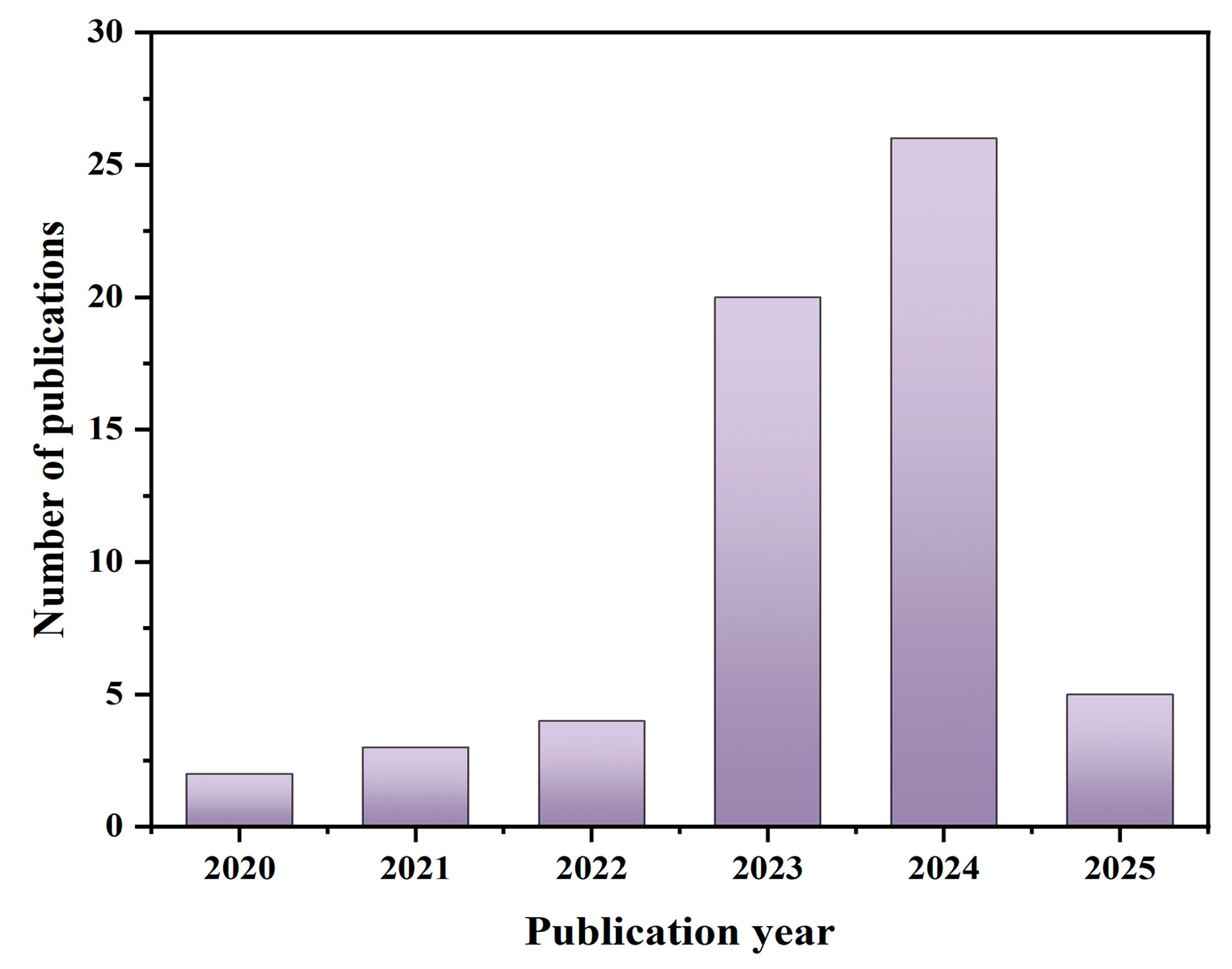
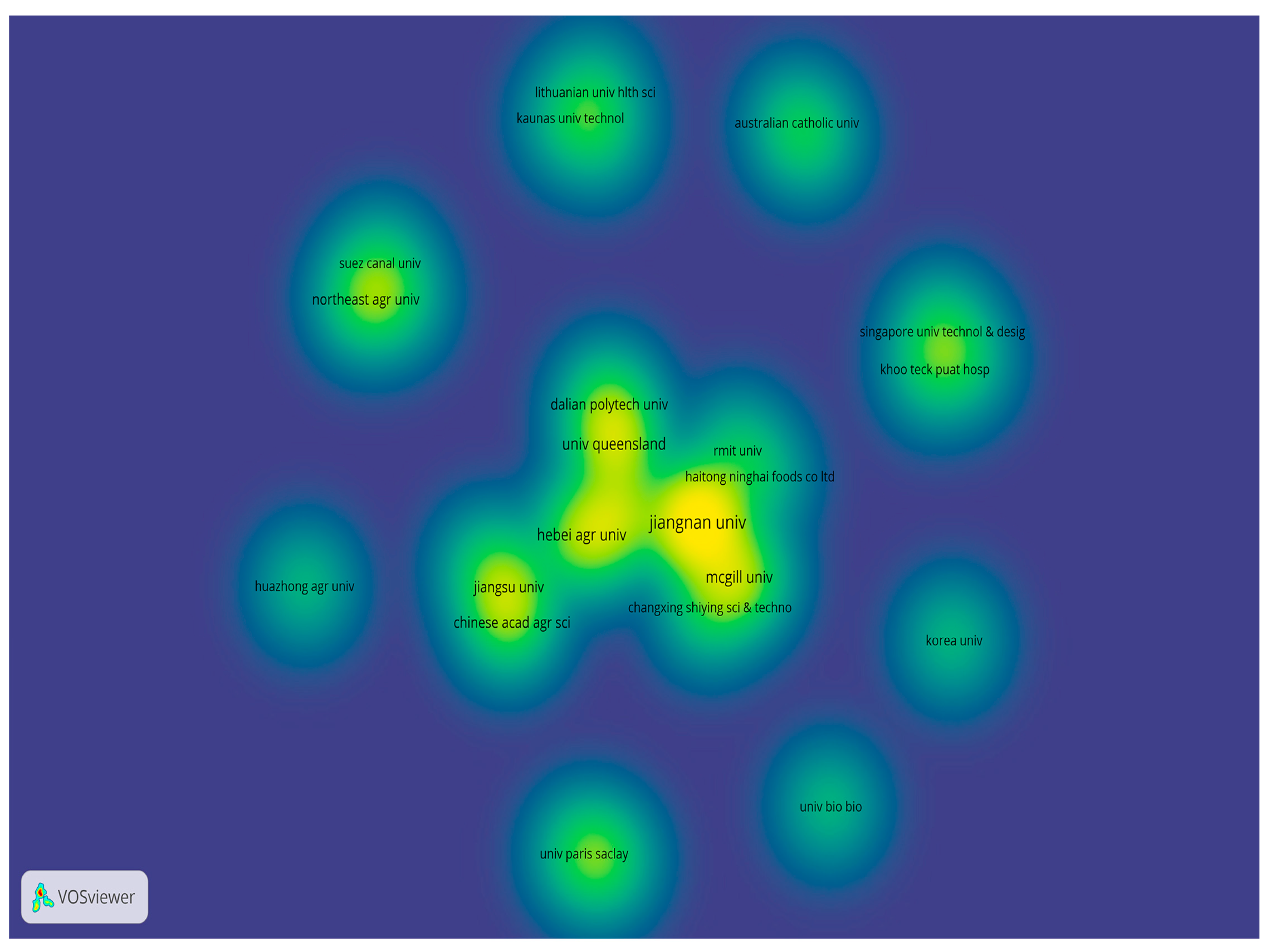
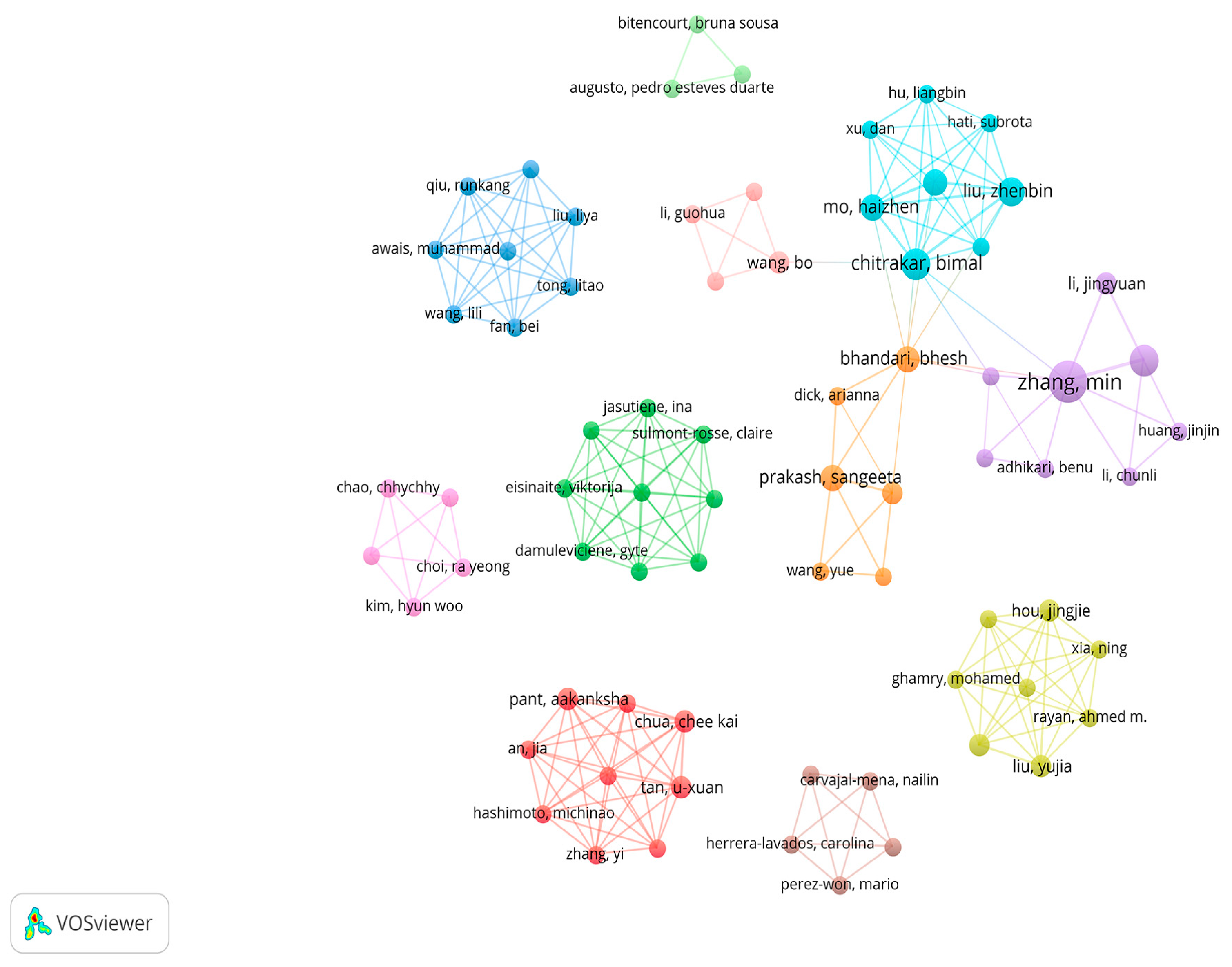
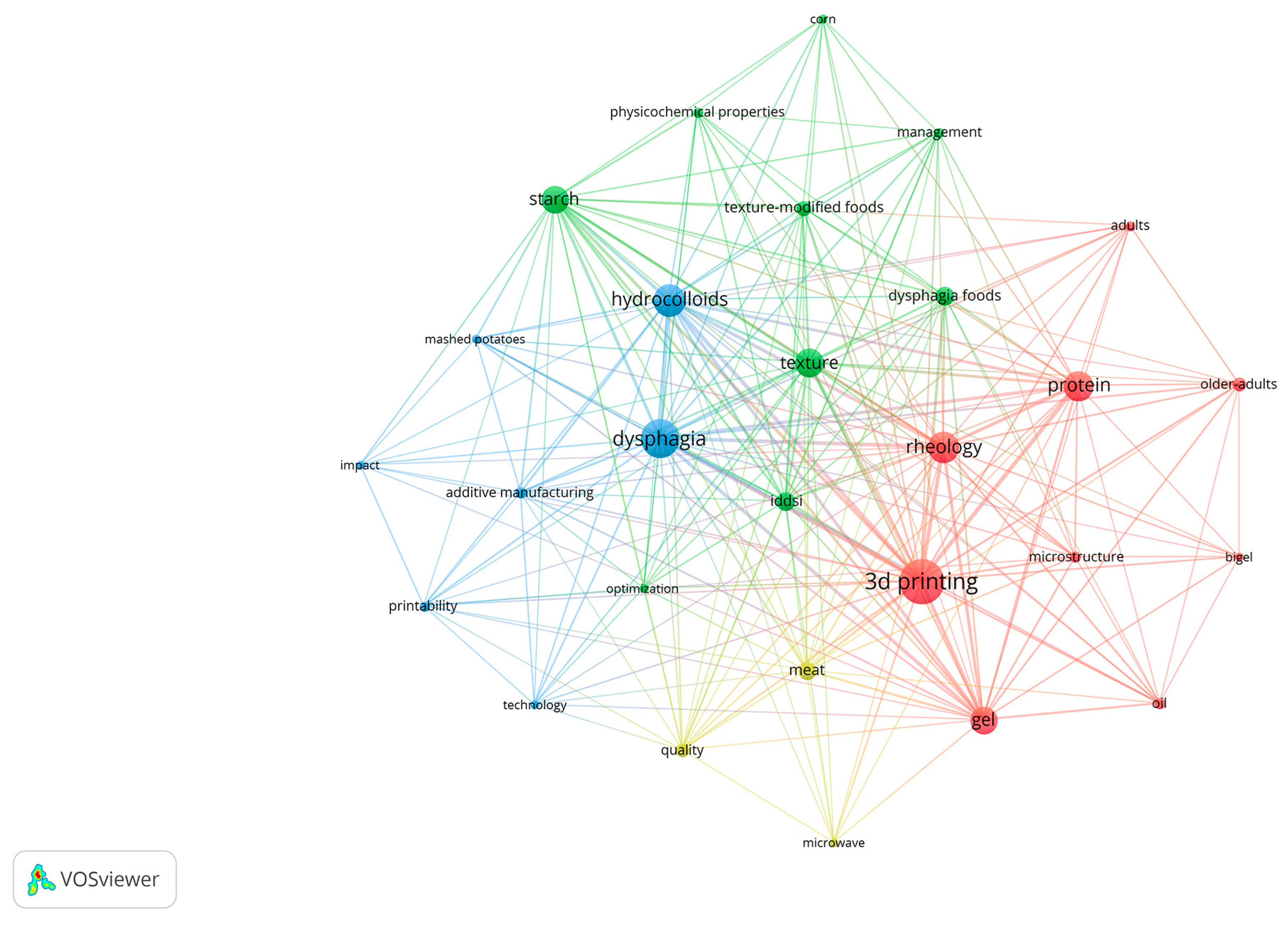
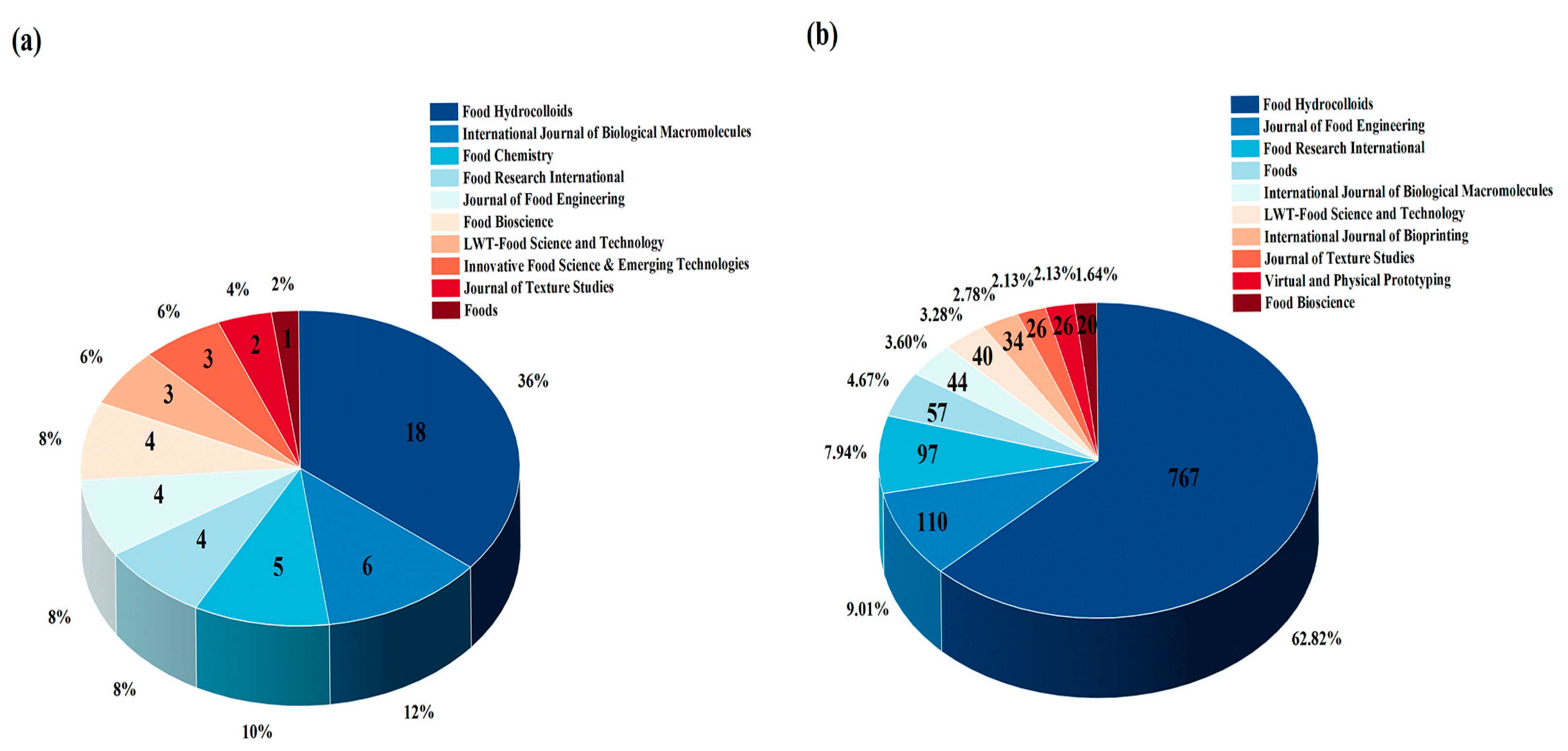
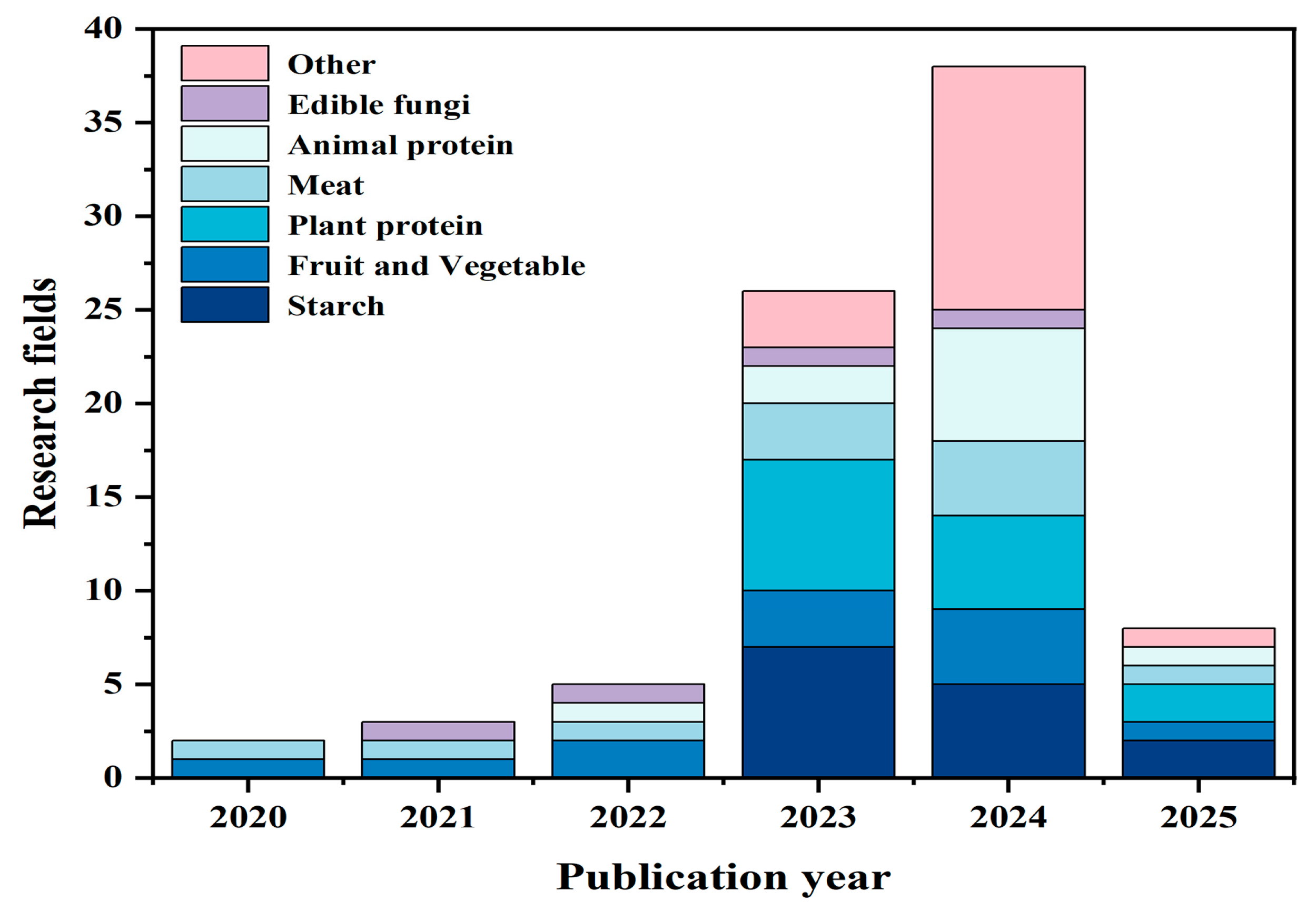
| Country | Publication Count | Citations | Citations per Publication |
|---|---|---|---|
| China | 38 | 780 | 20.5 |
| Australia | 10 | 408 | 40.8 |
| Canada | 9 | 132 | 14.7 |
| France | 5 | 31 | 6.2 |
| India | 4 | 193 | 48.3 |
| Brazil | 3 | 30 | 10.0 |
| Singapore | 3 | 368 | 122.7 |
| Korea | 3 | 74 | 24.7 |
| Egypt | 2 | 4 | 2.0 |
| Lithuania | 2 | 1 | 0.5 |
| Organization | Publication Count | Citations | Total Link Strength |
|---|---|---|---|
| Jiangnan University | 13 | 376 | 19 |
| McGill University | 6 | 89 | 9 |
| Hebei Agricultural University | 6 | 299 | 8 |
| The University of Queensland | 6 | 361 | 7 |
| Shaanxi University of Science and Technology | 5 | 288 | 7 |
Disclaimer/Publisher’s Note: The statements, opinions and data contained in all publications are solely those of the individual author(s) and contributor(s) and not of MDPI and/or the editor(s). MDPI and/or the editor(s) disclaim responsibility for any injury to people or property resulting from any ideas, methods, instructions or products referred to in the content. |
© 2025 by the authors. Licensee MDPI, Basel, Switzerland. This article is an open access article distributed under the terms and conditions of the Creative Commons Attribution (CC BY) license (https://creativecommons.org/licenses/by/4.0/).
Share and Cite
Shao, J.; Zheng, Z.; Hu, J.; Sriboonvorakul, N.; Lin, S. 3D-Printed Foods for Dysphagia: A Bibliometric Review. Foods 2025, 14, 2058. https://doi.org/10.3390/foods14122058
Shao J, Zheng Z, Hu J, Sriboonvorakul N, Lin S. 3D-Printed Foods for Dysphagia: A Bibliometric Review. Foods. 2025; 14(12):2058. https://doi.org/10.3390/foods14122058
Chicago/Turabian StyleShao, Jinge, Zhipeng Zheng, Jiamiao Hu, Natthida Sriboonvorakul, and Shaoling Lin. 2025. "3D-Printed Foods for Dysphagia: A Bibliometric Review" Foods 14, no. 12: 2058. https://doi.org/10.3390/foods14122058
APA StyleShao, J., Zheng, Z., Hu, J., Sriboonvorakul, N., & Lin, S. (2025). 3D-Printed Foods for Dysphagia: A Bibliometric Review. Foods, 14(12), 2058. https://doi.org/10.3390/foods14122058






